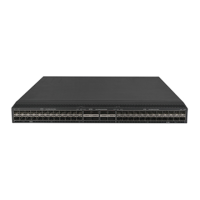6
Protocol-based VLANs
The protocol-based VLAN feature assigns inbound packets to different VLANs based on their
protocol types and encapsulation formats. The protocols available for VLAN assignment include IP,
IPX, and AT. The encapsulation formats include Ethernet II, 802.3 raw, 802.2 LLC, and 802.2 SNAP.
This feature associates the available network service types with VLANs and facilitates network
management and maintenance.
Layer 3 communication between VLANs
Hosts of different VLANs use VLAN interfaces to communicate at Layer 3. VLAN interfaces are
virtual interfaces that do not exist as physical entities on devices. For each VLAN, you can create
one VLAN interface and assign an IP address to it. The VLAN interface acts as the gateway of the
VLAN to forward packets destined for another IP subnet at Layer 3.
Protocols and standards
IEEE 802.1Q, IEEE Standard for Local and Metropolitan Area Networks: Virtual Bridged Local Area
Networks
Configuring a VLAN
Restrictions and guidelines
• As the system default VLAN, VLAN 1 cannot be created or deleted.
• Before you delete a dynamic VLAN or a VLAN locked by an application, you must first remove
the configuration from the VLAN.
VLAN configuration tasks at a glance
To configure VLANs, perform the following tasks:
1. Creating VLANs
2. (Optional.) Enabling packet dropping in the VLAN
Creating VLANs
1. Enter system view.
system-view
2. Create one or multiple VLANs.
{ Create a VLAN and enter its view.
vlan vlan-id
{ Create multiple VLANs and enter VLAN view.
Create VLANs.
vlan { vlan-id-list | all }
Enter VLAN view.
vlan vlan-id
By default, only the system default VLAN (VLAN 1) exists.

